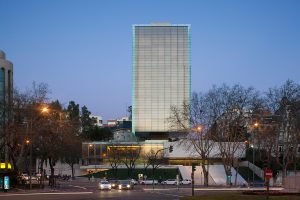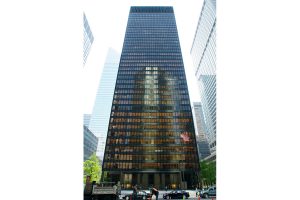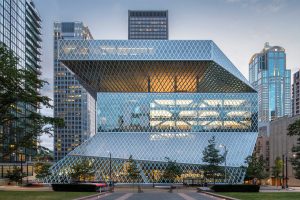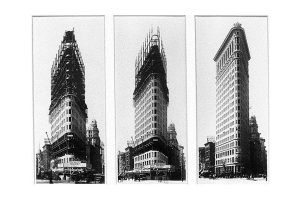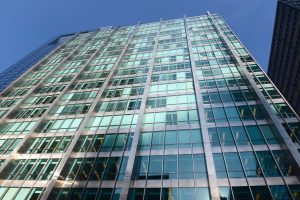The story of how the Petersen Automotive Museum leapt into the 21st century with a futuristic steel exoskeleton design strongly influenced by car culture
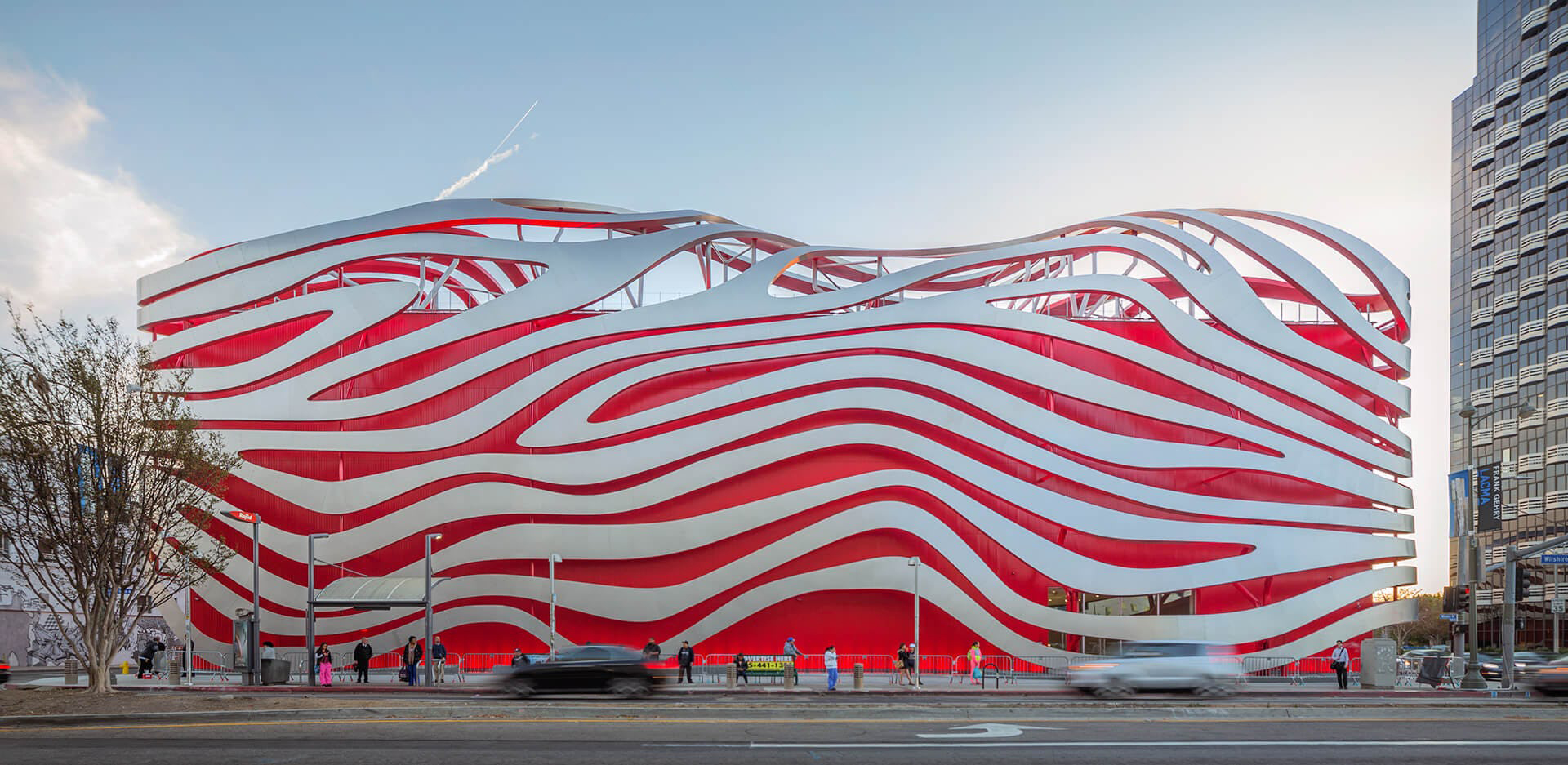
With its characteristic curving stainless-steel ribbons the exterior of the Petersen Museum re-interprets the ‘Googie’ architectural style influenced by car culture and the space age.
Photography by Tex Jernigan
Founded on June 11th 1994, by magazine publisher and car aficionado Robert E. Petersen, the $40-million Petersen Automotive Museum is owned and operated by the Petersen Automotive Museum Foundation. The museum was originally located within the Natural History Museum of Los Angeles County and later moved to a historic department store designed by Welton Becket, a well-known contemporary LA architect who died in 1969.
Six years after the department store closed in 1986, Robert Petersen selected the largely windowless site as an ideal space for his museum—allowing artifacts to be displayed without harmful exposure to direct sunlight.
The museum, opened in 1994, showcases championship-winning race cars, art cars, notable motorcycles, vehicles from Hollywood films, and other memorable vehicles. Pieces on view include concept cars from the 1950s and 1960s, the Batmobile from the Batman comics, the Jaguar XKSS formerly owned by Steve McQueen, a 1964 Aston Martin DB5 driven by James Bond in the film Goldfinger and the red Ferrari that Magnum PI drove in the 1980s TV series.
The Miracle Mile’s skyline was forever changed when, in 2015, a 13-month, $125 million renovation project was launched to renovate the nearly two-decade-old museum. The building’s façade was redesigned by the architectural firm Kohn Pedersen Fox (KPF) and features a dynamic wavy steel and aluminum façade. The main inspiration for the new exterior was the movement of a car, specifically the airflow over the body of the car. KPF decided that the new building would reflect the movement of air in an air tunnel over the body of a moving car. New “ribbons” made out of angel hair stainless steel on the front and top, and red-painted aluminum on the back and bottom, flow over and wrap the building. Acting as beams that support their own weight, these evoke the feeling of speed and movement, sitting atop the existing structural system much like the body of a car mounts to its frame. At night, the color and forms are lit up from within to accentuate the steel sculpture and act as a beacon on The Miracle Mile.
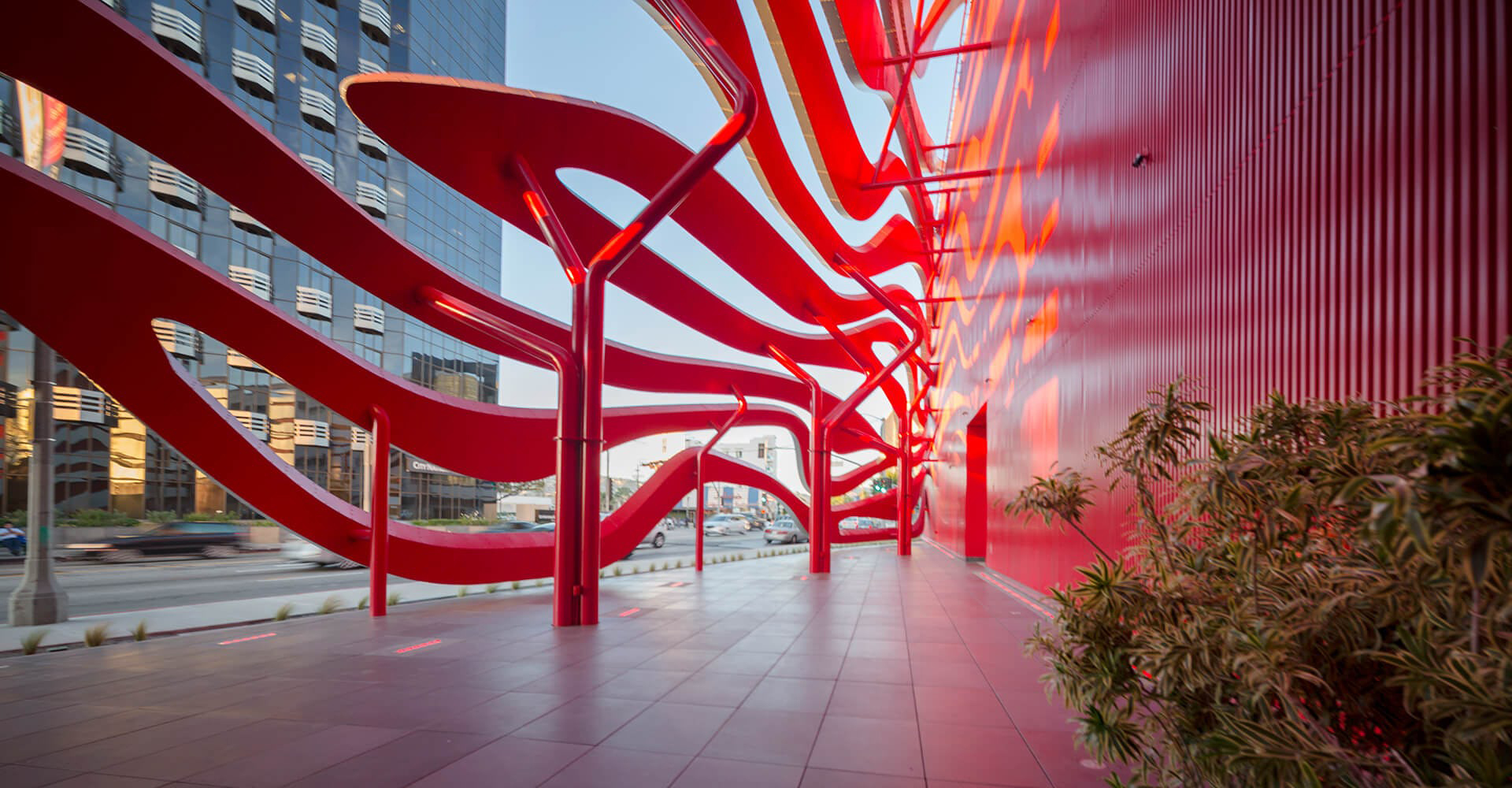
View from ground level showing the play on light between the dual steel ribbons and the red-painted corrugated aluminum rain-screen which acts as a backdrop. Each ribbon curve combines front and bottom surfaces in brushed stainless steel, while the back and top surfaces are made of textured aluminium coated with “hot-rod red” paint. The Petersen Museum.
Photography by Tex Jernigan
Los Angeles is a city that was brought to life by the automobile. The idea of Los Angeles architecture invokes thoughts of the mid-century modern movement led by architects such as John Lautner, and Wayne McAllister. This modern and space-age architecture, known as “Googie”, is characterized by upswept roofs, curvaceous shapes, and bold use of glass, steel, and neon. Googie architecture was a type of futurist movement influenced by car culture, jets, the Space Age, and the Atomic Age. It originated in Southern California with the Streamline Moderne architecture of the 1930s and was popular nationwide from roughly 1945 to the early 1970s.
The existing building, purchased by the Petersen Automotive Museum in 1994, was rectilinear and fairly straightforward in form. Because of its box-like form with no openings, it acted as a blank canvas for the design team. They encased the existing construction in a red-painted corrugated aluminum rain-screen system which acts as the backdrop for the 308 stainless steel structural ribbons, each uniquely designed. The bright red color of the aluminum backdrop is an obvious reference to sports cars. KPF Design Principal Trent Tesch comments “Our goal was to find a way to inject life into the building, with minimal intervention that would produce the maximum effect. The design offers an abstract veil of flowing ribbons, meant to invoke not only the spirit of the automobile but also the spirit of Los Angeles architectural culture.”
A flowing and dynamic design reminiscent of wind tunnel testing
The exterior stainless-steel exoskeleton is made up of more than 308 silvery steel ribbons assembled to form a dramatic contrast to the building’s “hot rod red” exterior. This 100-ton ribbon structure is made up of 14-gauge type 304 steel sections, 25 supports, and 140,000 custom stainless-steel screws.
All the architectural metalwork was produced by the long-established metalwork specialists A. Zahner Company. Throughout the company’s history, employees at Zahner have developed advanced metal surfaces and systems for both functional and ornamental architectural forms. ZEPPS, the Zahner-patented system for developing sculptural forms, was used to build curving stainless steel ‘ribbons’ which wrap the building, giving it a feeling of rapid motion. The result looks similar to the aerodynamic flow diagrams drawn in wind tunnel tests by automotive designers.
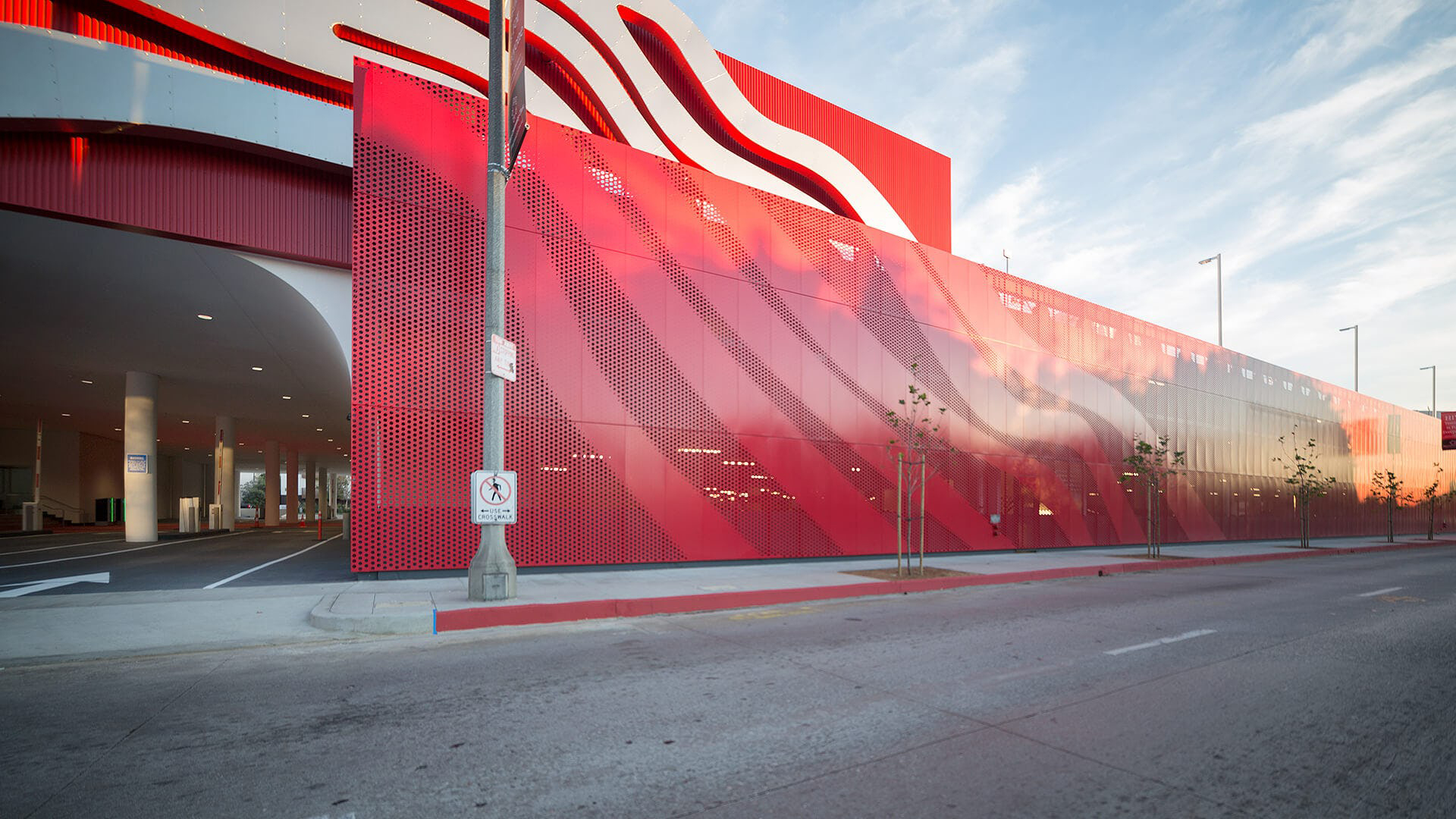
The custom perforated metal screen at the back of the building mimics the stainless ribbons to provide cohesiveness and tie in the Petersen Museum’s Parking Garage with the larger facade.
Photography by Tex Jernigan
The aluminum backdrop was completely custom and unlike any standard corrugated pattern. The corrugated profile formed an exact 90-degree angle, versus the typical sine wave that is commonly seen in corrugated metals. To accommodate for the custom nature of this design element, Zahner formed each of the corrugated panels in house, utilizing a custom die within the press brake. The front and bottom surfaces are made of stainless steel, while the back and top surfaces are made of textured aluminum coated with “hot-rod red” paint.
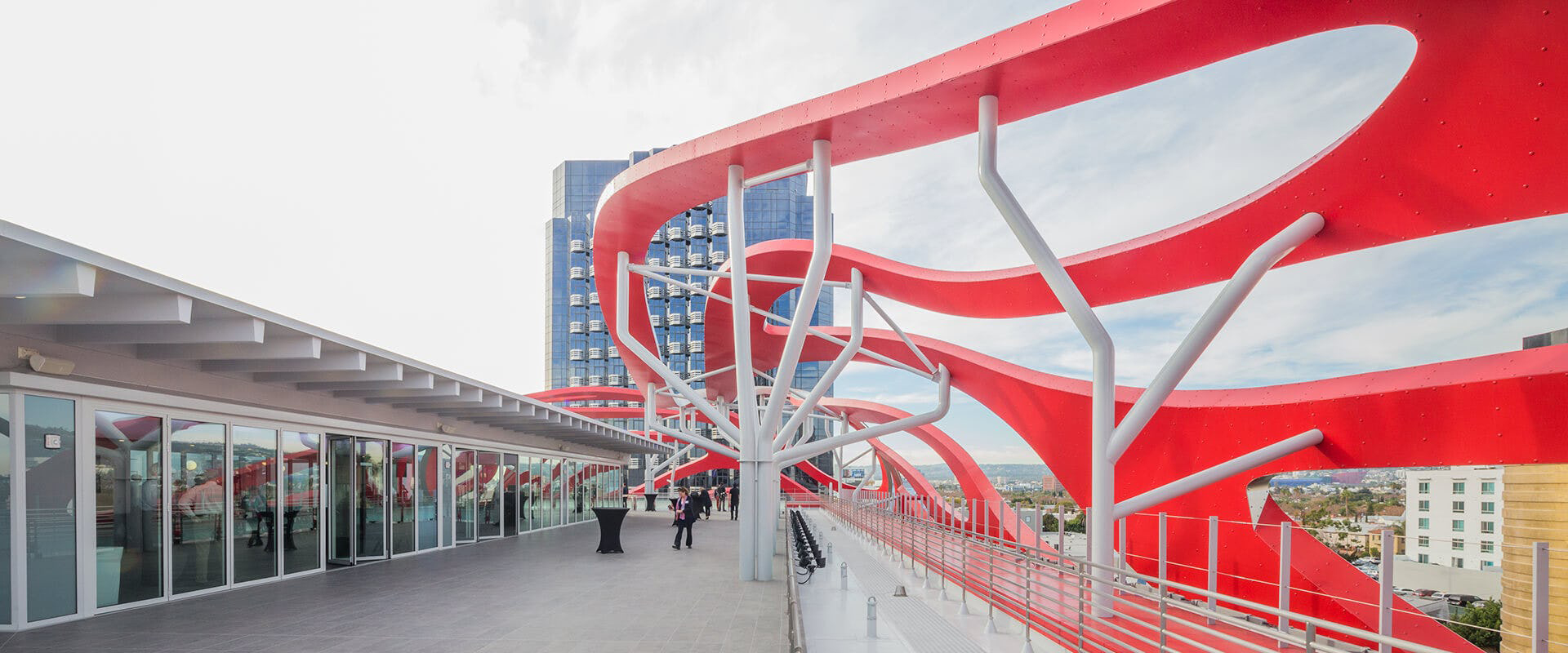
The rooftop glassed penthouse and terrace of the Petersen Museum provides a large open space of just under 10,000 sq.ft that fits up to 300 persons (standing) with panoramic views over LA and the Hollywood Hills. The cantilevered stainless steel ribbons form an aerial canopy that arches over the terrace.
Photography by Tex Jernigan
Structural steel columns shaped like hot rod manifolds
A monumental steel exoskeleton was needed to carry the loads from the red corrugated rain-screen as well as the cantilevered stainless- steel ribbons which flow over the rooftop to provide shading for a private event space as well as along the Fairfax Ave ground level. Working with the designers’ 3D models, Zahner’s team of engineers developed 25 tree-like structural columns to support the steel ribbon assemblies that weigh about 100 tons in total. The ‘tree shape’ of the structural columns was inspired by car engine hot rod manifolds. while the customized stainless-steel screws were fabricated for the project to imitate the appearance of early 20th-century automobile fasteners.
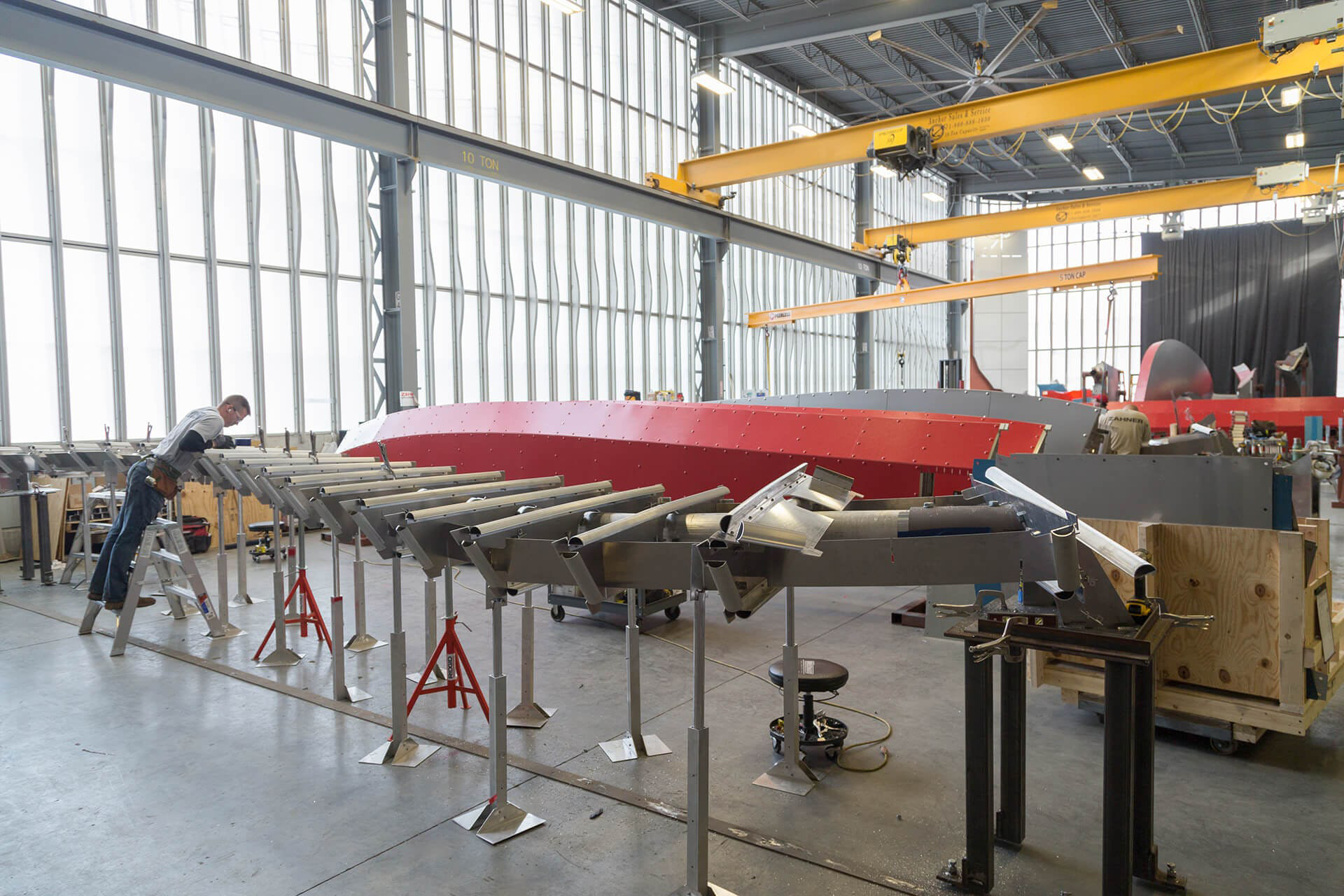
For the exterior of the Petersen Museum each curve was broken down into manageable parts for manufacturing: a series of patented aluminum structural components were pre-assembled in Zahner’s workshops before being assembled on site.
Image from A. Zahner Company
Before starting the manufacturing process the engineers examined the geometry of the architect’s 3D model. Each band required custom curved structural steel that was analyzed and made to measure according to the exact radii provided by the model. The dual curves were broken down into more manageable, structural components to allow for greater precision within the manufacturing process, and quicker job site assembly. These components were then pre-assembled at the workshop to compose the structural form before assembly. Using aluminum extrusions rather than steel allowed for a lighter load on the structure of the façade as well as more cost-efficient manufacturing.
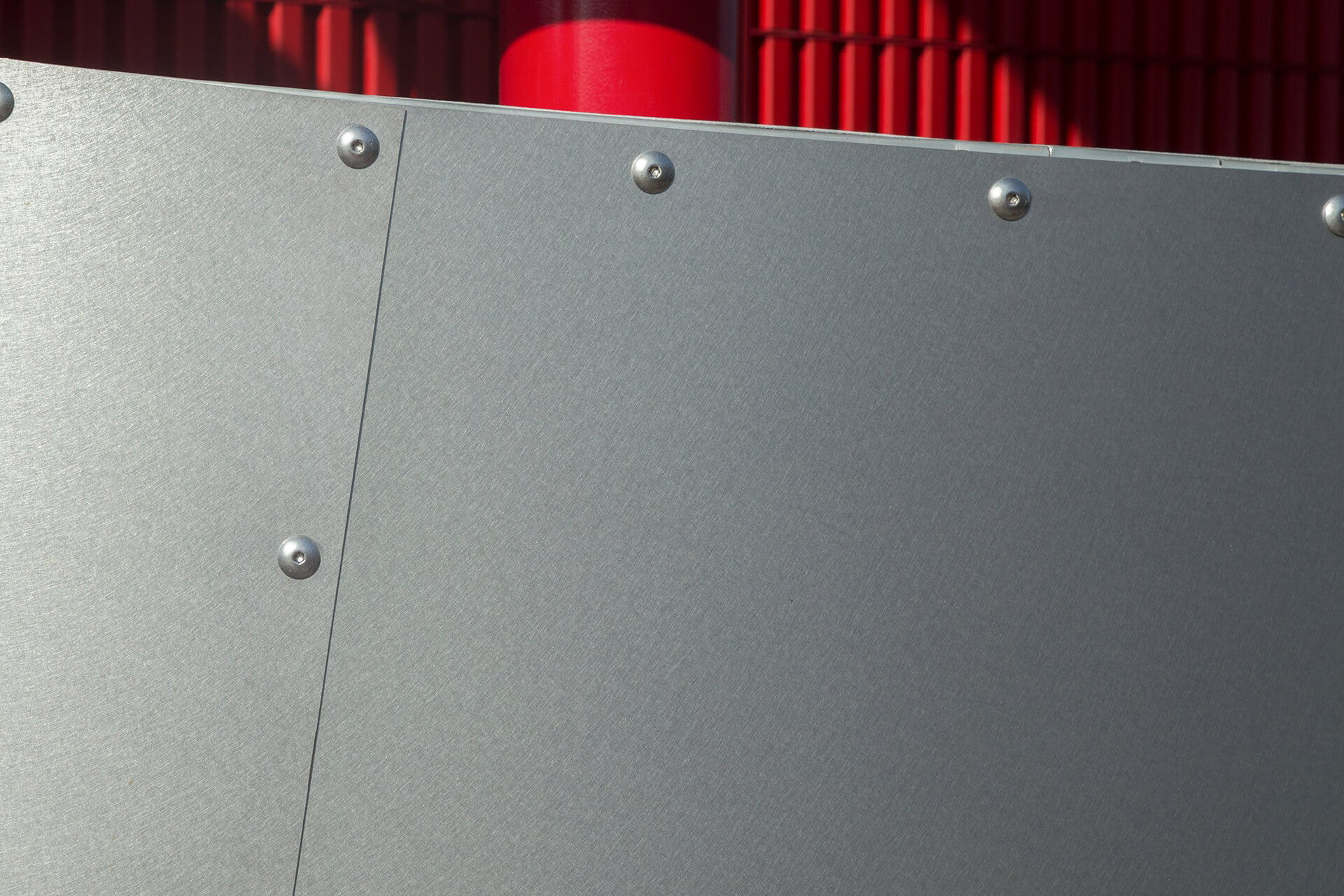
Angel Hair is a patented process to soften the glare of standard grain finishes. It uses precision-controlled machinery to etch stainless steel with a fine grain to create a smooth uniform light-diffusion metal surface.
Image from A. Zahner Company
The dual curves for the Petersen Automotive Museum were clad with Zahner’s Angel Hair Stainless Steel surface. This reflective metal sheeting was first developed for the famous Guggenheim Museum in Bilbao designed by Frank Gehry. At night the building’s flowing exterior envelope is illuminated at night by 866 individually controlled LED fixtures.
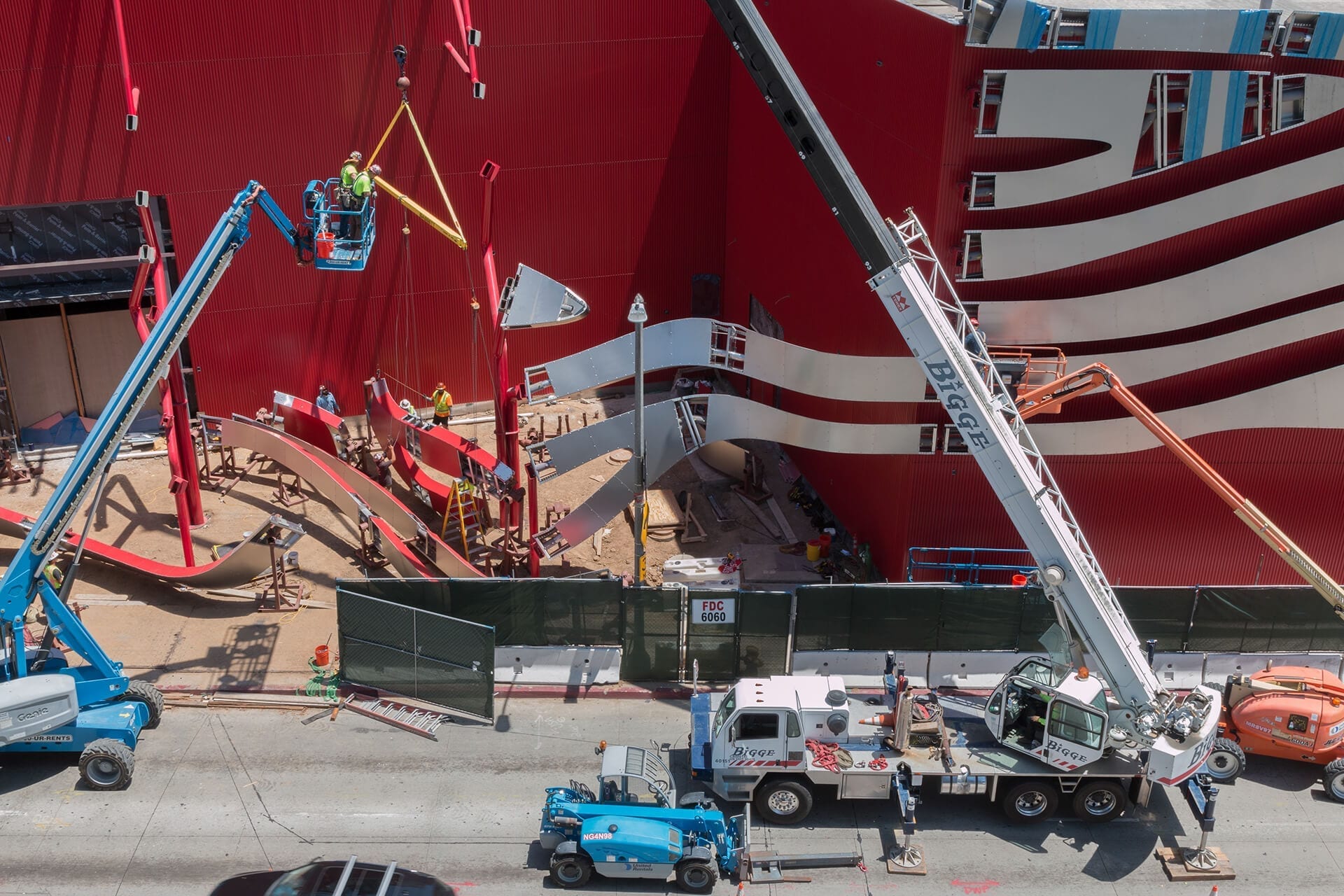
Using aluminum extrusions rather than steel allows for a lighter load on the structure of the façade. Breaking down the dual curves into units allowed also for much quicker assembly on site. The Petersen Museum.
Image from A. Zahner Company
An extensive collection of rare and valuable vintage cars
The museum’s exhibition space totals 95,000 square feet (8,825 square meters) spread across three levels bringing together 25 galleries representing the history, industry, and design of the automobile.
The visitor experience is intended to begin on the top storey, which is dedicated to the history of the automobile. The upper floor also showcases the exhibition Southern California: A Region in Motion, which uses interactive videos to demonstrate how LA “grew out, instead of up, like most cities”.
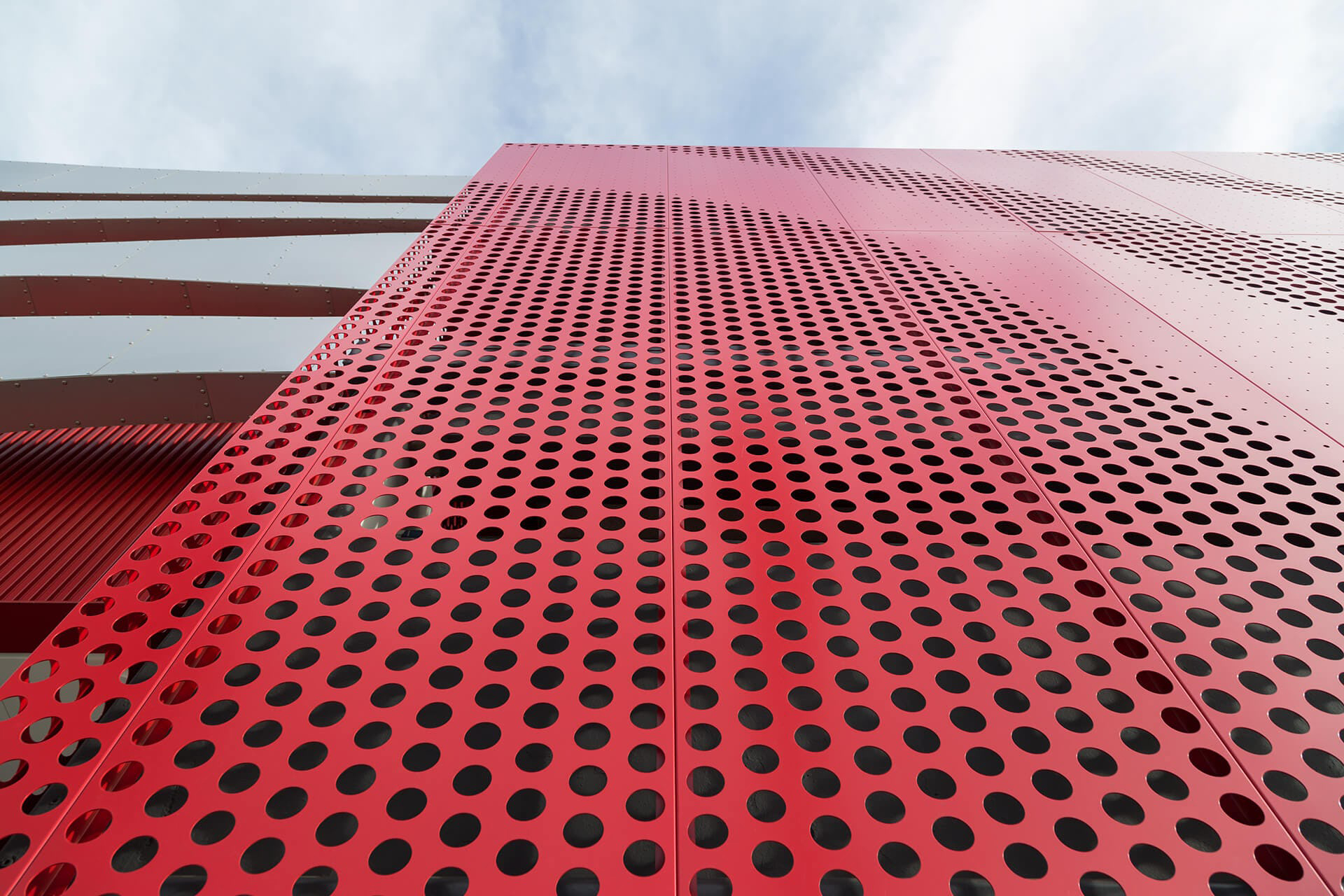
The red-painted perforated aluminium screen that forms a backdrop to the wavy stainless steel Angel Hair ribbons for the façade of The Automotive Petersen Museum.
Photography by Tex Jernigan.
The ground floor focuses on car design showcasing an array of extravagant automobiles. It includes French Art Deco cars from the 1930s, an exceptional period for automobile design. Among the rare vintage models, visitors can admire a 1939 Delahaye Type 165 and the famed 1936 Bugatti Type 57SC Atlantic, by some accounts the most valuable car in the world. A “Precious Metal” exhibit in the Bruce Meyer Family Gallery features an estimated $120 million worth of silver-skinned American and European cars.
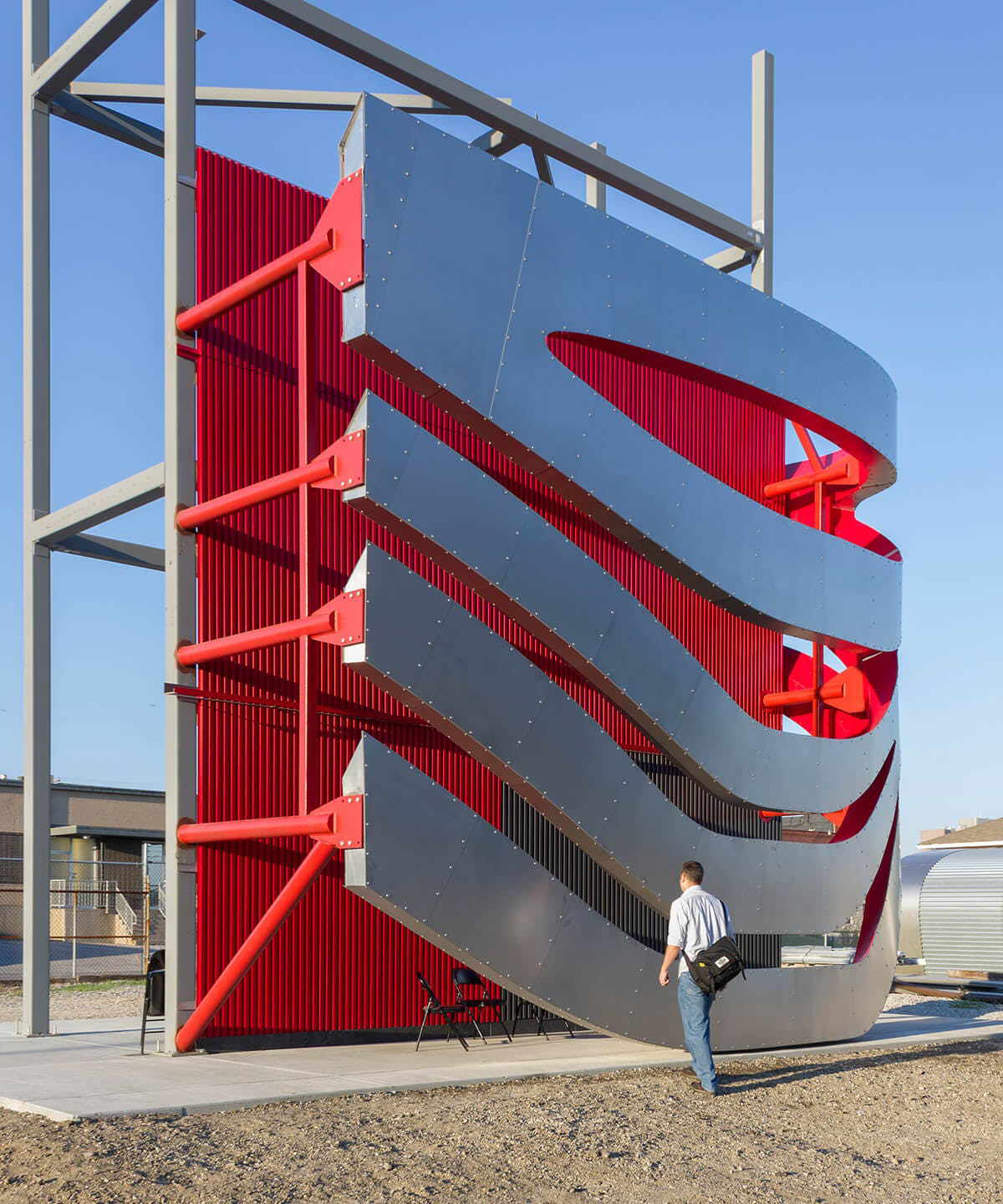
The full-scale mock-up a section of the façade of The Petersen Automotive Museum in red-painted aluminium and wavy ribbons in stainless steel Angel Hair. The red backdrop was clearly changed since the mock up to a perforated finish rather than vertical strips.
Image from A.Zahner.
The second floor is principally concerned with industrial engineering—including design, performance, and a collection of interactive teaching exhibits. Special displays on the industry floor cover racing, motorcycles, hot rods, and customs. The third floor chronicles the history of the automobile with an emphasis on the car culture of Southern California. And if visitors are still feeling up to it there are an additional 125 to 150 vehicles from the 300-plus pieces from the permanent Petersen collection which are displayed in the underground “Vault” located in the basement level of the building. By now you will have understood that one of the ambitions of the museum is to attract return visitors.
In February 2019 the Petersen Museum celebrated its 25th-anniversary celebration by parading some of Hollywood’s most famous cars past Los Angeles landmarks such as the “Little Miss Sunshine” Volkswagen bus and the James Bond XK-R car from “Die Another Day.”
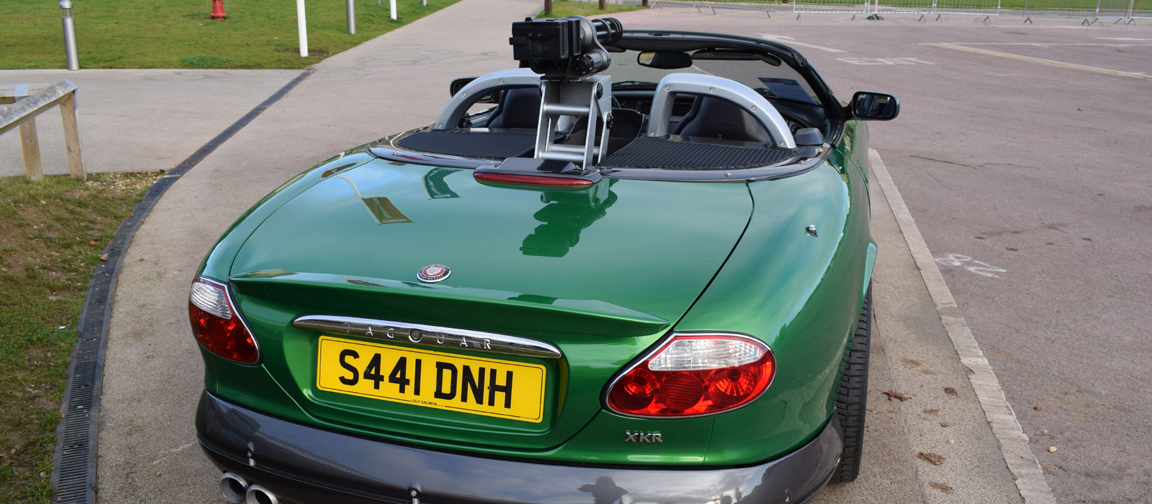
The villain’s (the character Zao played by Rick Yune) car, the Jaguar XK-R complete with M134 Minigun, used in the 20th James Bond 2002 film Die Another Day. Part of the exhibits shown in The Petersen Automotive Museum, Los Angeles.
Image from The Jaguar Daimler Heritage Trust.
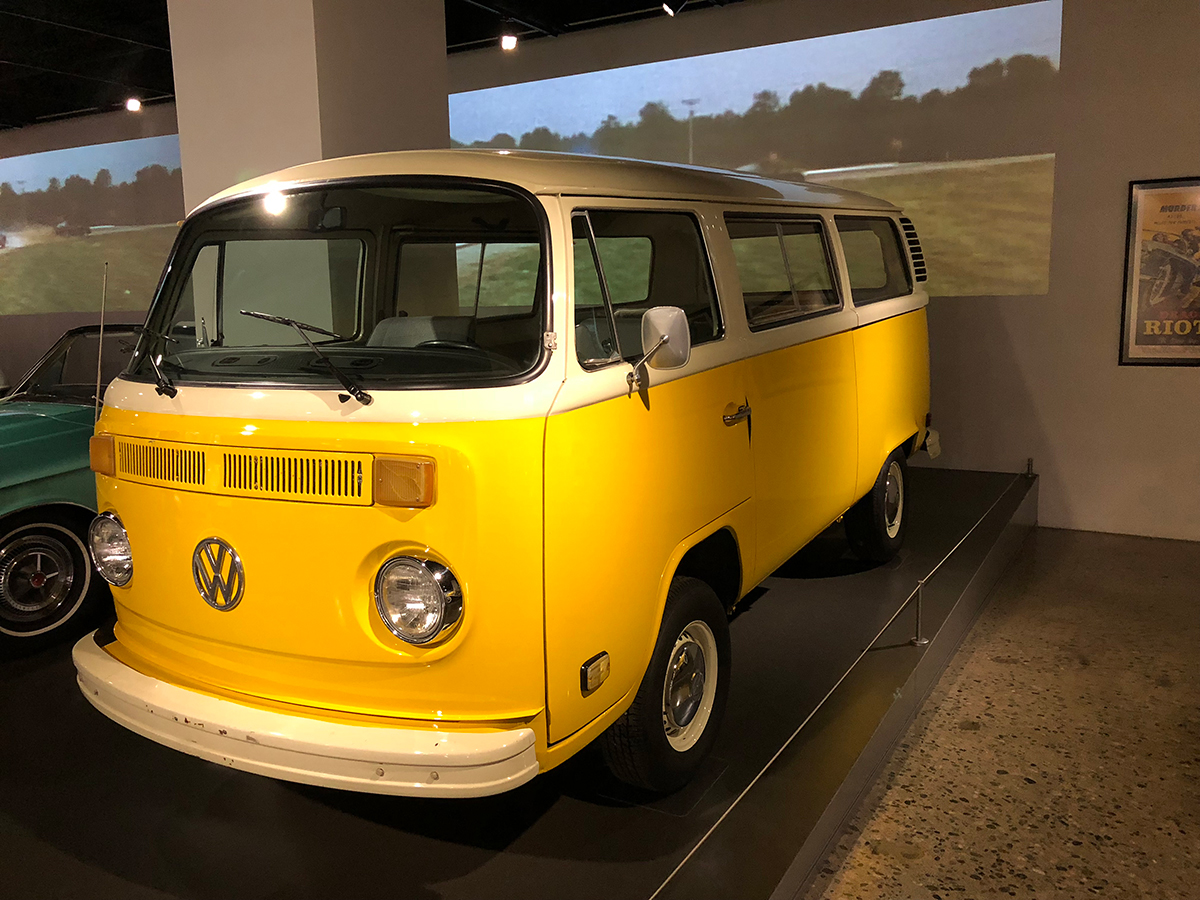
The yellow VW Camper van used in the 2006 film Little Miss Sunshine exhibited at The Petersen Automotive Museum, Los Angeles, California.
Image from Film Oblivion.
Attracting the younger generation with a trove of interactive technology
To make the museum more appealing to younger audiences a trove of interactive technology was installed. Where once were only 10 flat-screen TV monitors are now a flotilla of interactive electronics, including 47 Panasonic projectors, 35 interactive touchscreens, 25 LED monitors, 291 three-dimensional displays of engines and scale models and several enormous projection walls that will better capture the excitement of motoring and automotive art. The new museum also features 10 Microsoft Xbox Forza driving simulators, where visitors can race against virtual professionals or against one another. To get cars into and out of exhibit spaces, the Petersen has a car elevator, said to be one of the largest in Los Angeles, capable of lifting 14,200 pounds from street level to the top floor.
Through this extensive renovation, the Petersen Automotive Museum aims to be in the same league as the BMW Museum in Munich or the Museo Ferrari in Maranello, Italy. It also benefits from the attraction of LA’s famed Museum Row, which features buildings such as the Los Angeles County Museum of Art (LACMA), originally designed by William Pereira, again one of the leading lights of the futurist Googie movement that prevailed at the time in California. Located just opposite the Petersen museum is the much loved May Company building (renamed the Saban building) with its characteristic Streamline Moderne style. It has been recently renovated as part of Renzo Piano’s design for the Academy of Motion Pictures Arts and Sciences (AMPAS) which is scheduled to open in April 2021.
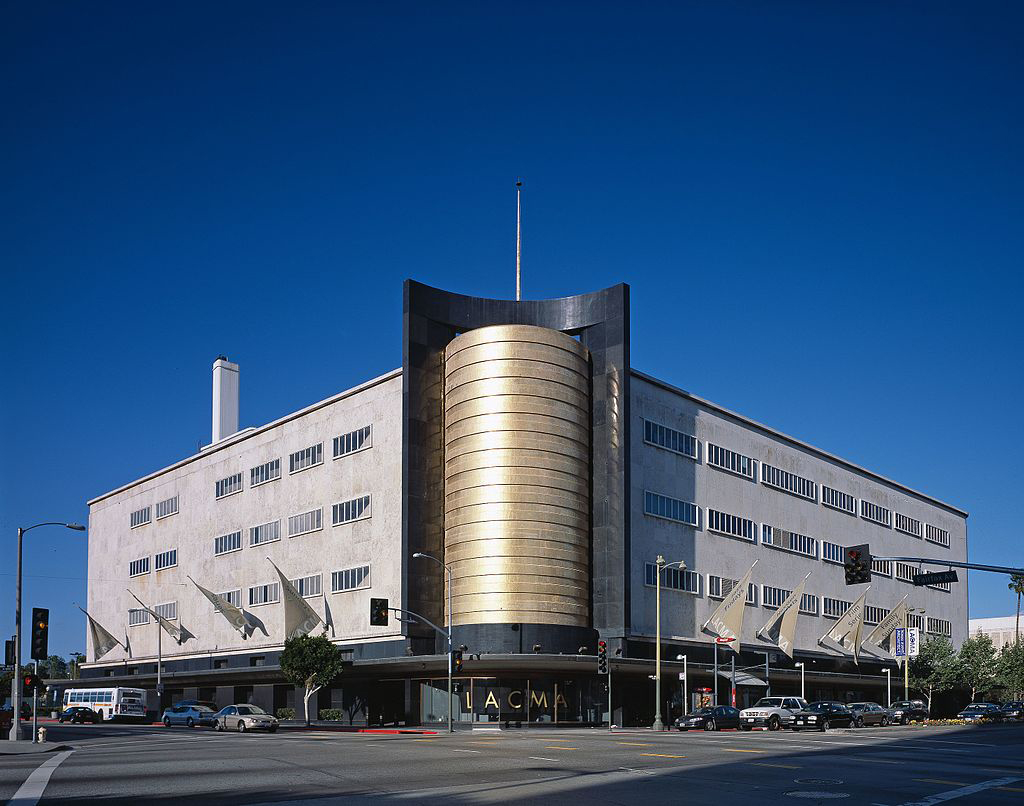
The former May Company building was a department store designed and built in 1939 by architects A. C. Martin and Samuel Marx. Its eye-catching southwest corner hemi-cylinder, clad in Italian gold-glass mosaic, was designed to attract suburban motorists.
Photography by Carol Highsmith
According to KPF co-founder and Chairman A. Eugene Kohn, the new design was “intended to express constant motion, suggesting speed, aerodynamics and the movement of air. While its other museum neighbors are the gentlemen in black tie, this is a ballerina.”

